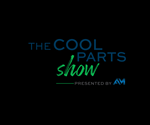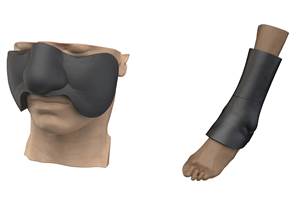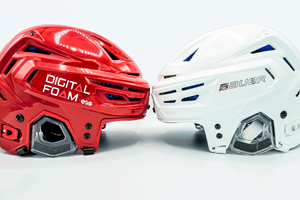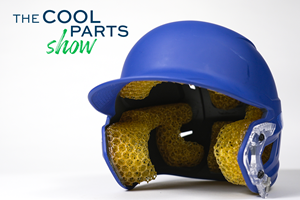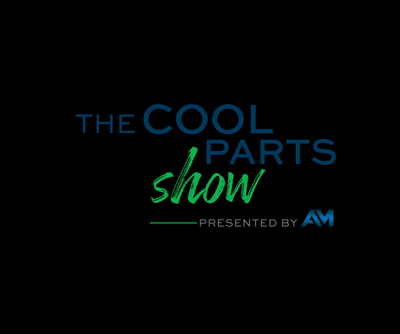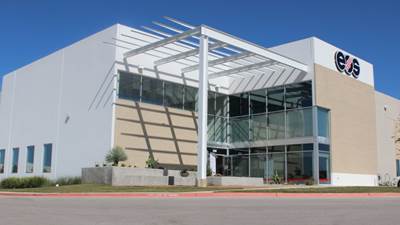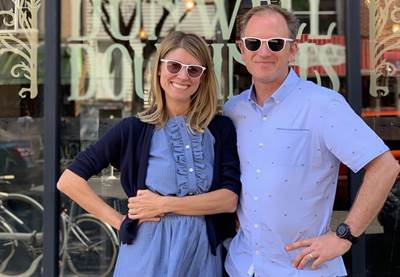Shoe Insoles Precisely Tailored to Individual Feet: The Cool Parts Show #4
This episode of The Cool Parts Show looks at how 3D printing will deliver tailored products. Scanning feet for their geometry and pressure enables Aetrex and EOS to manufacture insoles that are unique to individual wearers.
Every foot is different. Footwear maker Aetrex has technology able to quickly measure the differences — its Albert scanner provides data about the shape, dimensions and pressure map of individual feet. Now, additive manufacturing (AM) is allowing Aetrex to take the next step. Insoles tailor-made to the individual are 3D printed with a customized array of “digital foam” geometries providing different levels of resistance and support to match the foot’s pressure areas. The company’s partner in this is EOS, which manufacturers the custom insoles through selective laser sintering.
In this episode of The Cool Parts Show, I talk about the insoles that were customized to my feet, and learn that my cohost is jealous because she has been living with orthotic insoles that are not tailor-made.
The Cool Parts Show is a video series from Additive Manufacturing Media that explores the what, how and why of unusual 3D printed parts. Watch more here.
Have a cool part to share? Email us.
Transcript
Peter Zelinski, Additive Manufacturing
One of the promises of additive manufacturing is products that will be tailored specifically to your body, specifically to you as an individual. We've got an example of that on this episode of The Cool Parts Show.
Peter Zelinski
I'm Pete Zelinski.
Stephanie Hendrixson, Additive Manufacturing
I'm Stephanie Hendrixson.
Peter Zelinski
We are with AdditiveManufacturing.Media and this is The Cool Parts Show.
Stephanie Hendrixson
This is our series where we talk about cool parts 3D printed by viewers like you. So Pete, it's been a couple of episodes since we've seen a part from you. What do you have today?
Peter Zelinski
I've got a part. I've got a question first. What do you know about mass customization?
Stephanie Hendrixson
Mass customization, I guess I think about that in contrast to mass production. So where you're manufacturing a lot of an identical product. Not necessarily because it's the best fit for all the consumers but probably because you've made some investment in tooling and so you're kind of tied to that design. Whereas what mass customization is all about is manufacturing a tailored product for each individual. And when you get to a process like 3D printing where you're not limited by tooling that becomes possible.
Peter Zelinski
Yeah. So I've got an example of mass customization an example right here. These are custom insoles made through additive manufacturing made for my special feet. There are two companies involved in this. Aetrex is the footwear company. EOS is the company that did the additive manufacturing and these insoles are based on a ton of data taken from a scan of my feet.
Stephanie Hendrixson
OK. So you asked of a mass customization but can we just talk about insoles for a second. So I actually have a pair of orthotics that I had made the conventional way. I went to the doctor's office, had to put my feet in this box of foam, waited like a month to go pick them up and the orthotics that I have they're solid. They're kind of rigid all the way through. They don't look anything like this. So I have a couple of ideas already about how 3D printing might change this but I want to hear more about these and what you've learned from this process.
Peter Zelinski
This is a means of supporting our feet in a way they haven't been supported before. Let me introduce you to Evan Schwartz president of Aetrex.
Evan Schwartz, Aetrex
Each foot can have different lengths could have different widths, and most importantly has different arch types as well as varying pressure points. Our goal has always been to support the foot, bring the ground up to the foot, realign the body and most importantly offset pressure and redistribute pressure throughout the foot. And of course then help with not only body alignment, but getting the body back into proper position. Because most people don't wear the proper footwear and actually don't often pay attention to their feet and because of these variables people can suffer from things like heel pain, arch paint, ball foot pain, plantar fasciitis, Achilles problems, the list goes on and on for the different types of conditions that are common and exist. What we're excited about here is launching a product that uses additive manufacturing to sort of revolutionize the way feet are treated and allows us to offset these pressure points and bring the ground up to the foot in a very specific way.
Stephanie Hendrixson
Okay. So bringing the ground up to your foot. That's a really neat way of visualizing what an insole does. So how do we go from the scan to these insoles in front of us right here.
Peter Zelinski
Right. So the scan is a really important part of it. It uses what tricks calls their Albert Scanner which has like 500 gold-plated sensors and 18 cameras and 960 LEDs and receptors. And I stepped into that and the result was more data than I thought would ever be attached to my feet ever. And data about the dimensions of my feet and the shape, but more significantly data about the pressure map on the underside of my feet. The pressure of how the ground is contacting my feet now. All that data the pressure profile and the dimensions of my feet, that goes to EOS. That's converted into the special build file just for this part, just for these special insoles. EOS 3d prints it. I'll let EOS take it from there here. Here is EOS's Fabian Krauss.
Fabian Krauss, EOS
So we as the manufacturer we receive the pressure scan as well as a 3D file of the foot from Aetrex and this information is then converted into the lattice file. How do we do that? We have a large library and a simulation tool behind it to convert a physical property which the consumer would like to have in this insole into a digital foam.
Peter Zelinski
So the 3D printing process, the additive manufacturing process is SLS, selective laser sintering. A laser moving through polymer in a powder form solidifies that polymer layer by layer, builds the part that way. The material is TPU, a responsive soft polymer. And 3D printing is used to create this complex geometry, and their term for that is digital foam. So we think of foam and the springiness comes from the air that's mixed in with the material right. But the foam properties here come from the geometry of each of these little 3D printed areas. Basically Aetrex and EOS together invented many different types of spring geometries to get different kinds of responsiveness and all of these little 3D printed springs were matched basically square by square by square to this map of the pressure area of the underside of my foot to get this leveled out responsiveness in the insoles all the way through. So this is this is not just tailored to the shape of my feet. You get in tight here and you look at all these little spring geometries. This is tailored to the forces that my feet want to see.
Stephanie Hendrixson
All right so you had your foot scanned, EOS got the pressure data, they took all this pressure points and converted them into these individual spring designs, 3D printed these insoles, sent them to you. How long did this process take?
Peter Zelinski
Right. It was fast. Like the scan 30 seconds like it was so fast. Then it was about two weeks when I got the insoles. And I bet it could have been faster than that. I think I was just doing their system and in their queue a couple of weeks I had them right.
Stephanie Hendrixson
So I can't help but notice that is a much shorter lead time than my orthotic experience. But we haven't talked about what it's like to wear these. Are they comfortable?
Peter Zelinski
Yes. So I have been wearing them. Spent a work day wearing them, lot of standing, lot of walking. I'll tell you at first they feel weird. They feel lumpy and a little wrong because my feet are being touched in places they haven't been touched before. But then I get used to it fast. And then there is this energy of walking right. That phenomenon of the ground coming up to meet your feet. Yeah I think there's something to that. It becomes freer and lighter to stand to walk. Like using your feet just has more energy to it.
Stephanie Hendrixson
So with these orthotics you're not only avoiding those health problems that Evan was talking about you're actually having a better experience while you're standing, walking, moving around. Where does Aetrex see all this headed?
Peter Zelinski
Yeah. So actually both Aetrex and EOS had thoughts about that. Let's hear from both of them.
Evan Schwartz
We believe that 3D printed orthotics can change footwear in almost every way. When you're able to take data about someone's feet, collect that data and then turn that into something that's very specific to them. So imagine that we can print something to a millimeter. So if you have a pressure point that's let's call it a centimeter or few millimeters, we can actually offset that pressure by printing a specific structure or lattice under that spot. And so that allows us to custom build not only orthotics but eventually footwear that takes this data and then makes it specifically to you.
Fabian Krauss
So next steps, natural next steps in the evolution would be taking the concept of a insole and combine it with a midsole. Taking the concept of an insole and combine it with protective environment. Taking the concept of an insult and apply it to other parts of the body for protectors, for assistive devices, ONP devices, helmets and the like. So this is really a very important step in the evolution or the revolution of products that by digitizing foam and by digitizing foam successfully you can now apply it to really any application around the human body.
Stephanie Hendrixson
All right. So these are custom 3D printed insoles made with a totally digital manufacturing process. You've had your feet scanned, EOS received that scan data, they mapped all these different little spring designs onto the different pressure points in your foot. 3d printed them and mailed them right to you. This is what mass customization with 3D printing kind of looks like.
Peter Zelinski
Yeah that's right. So Aetrex, EOS can produce tons of insoles but none of them have to be identical and all of them can be tailored to individuals.
Stephanie Hendrixson
All right. So just one more thing before we go. I've actually been pretty frustrated with my old orthotics so I had my feet scanned, too. Yeah I did. So pretty soon I'm gonna have my own 3D printed insoles that are kind of like yours but made just for me.
Peter Zelinski
All right. All right. Even more mass customization. Do it for The Cool Parts Show. Thank you for watching. Email us: CoolParts@additivemanufacturing.media. Tell us about your cool additive manufactured part. And don't forget to subscribe.
Related Content
3D Systems, Klarity Partner to Expand Access to Patient-Matched Radiotherapy Innovations
Klarity has added 3D Systems’ VSP Bolus to its radiotherapy solutions, enabling radiotherapy clinics in the U.S. and Canada to embrace 3D printing technology without investing in costly, time-consuming software.
Read MoreEOS Launches Digital Foam Architects Network
EOS created the collaborative additive manufacturing alliance to accelerate time-to-market for 3D printed foam applications.
Read More3D Printed Lattices Replace Foam for Customized Helmet Padding: The Cool Parts Show #62
“Digital materials” resulting from engineered flexible polymer structures made through additive manufacturing are tunable to the application and can be tailored to the head of the wearer.
Read MoreResearchers Develop Method for Creating Customized 3D Printed Metals With Contrasting Properties
Researchers were able to use 3D printing techniques and tweak printing parameters to produce a 3D printed metal with different microstructures that create stronger and weaker regions in the exact locations in the metal that they wanted.
Read MoreRead Next
Additive Manufacturing Media Announces New Web Series, The Cool Parts Show
Additive Manufacturing Media Announces New Web Series, The Cool Parts Show Series will focus on unique applications of 3D printing for manufacturing
Read MoreEOS Opens New Location in Texas
Located near Austin, the facility is to be the first of several additions to the company's presence in North America, its fastest-growing market.
Read MoreFitz Frames Brings Mass Customization to Eyewear with Affordable 3D Printed Glasses Frames
Glasses don’t need to be ill-fitting and frustrating to buy. Fitz Frames offers a different kind of shopping experience (using augmented reality and 3D measurement) to produce custom glasses with 3D printed frames that are affordable, durable, comfortable and stylish.
Read More

